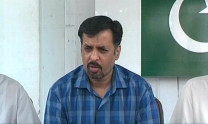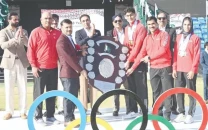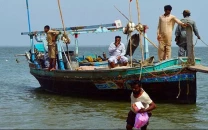Pushing for revival: Sindh’s ancient art forms sink into oblivion
Experts believe increased dependency on machinery, mass production have compromised originality of handiwork
1607243240-8/Image-from-iOS-(7)1607243240-8-640x480.webp)
Home to the River Indus and the many dynasties which thrived on its fertile banks, Sindh boasts a heritage as old as 7,000 BC. In all those millennia, the region has graced many rules and regimes, acting as an incubator for the most ancient of cultures.
Sindh’s rich history and culture has long been preserved in the art of its people, being passed down from one generation to another, often as oral lore.
Today, however, despite its strong heritage, the art of Sindh’s indigenous people is seen to be flailing on the edge of forgotten times, meriting a crucial need for preservation and revival.
According to Sindh Indigenous and Traditional Crafts Company (SITCO) executive secretary Abdul Hameed Akhund, the revival of Sindh’s native art is an effort that requires passion. “We have to develop the traditional spirit among artisans and general public if we are to ever successfully preserve and promote this art,” he said.
SITCO, a public sector organisation, has been working to preserve Sindh’s traditional arts and crafts by mobilising and empowering young craftspersons in the region through various resources.
Per Akhund, a former bureaucrat who has been contributing to the cause in his personal and professional capacities, initiatives for revival of indigenous art have received little response so far. Where previously the movement had the full participation and support of local communities and their chiefs, the situation today appears to be less favourable than in the past.
“Contemporary artisans lack the fervour of their forefathers, who have sustained our culture for centuries. Today’s modern technology has changed the appearance of our art. We now mass produce ajraks by tens and thousands, but the use of machinery in doing so has taken away its soul and compromised the originality of handwork,” lamented Akhund.
According to indigenous art expert Ghulam Hyder Daudpota, the dependency on modern machinery has been rapidly replacing handmade techniques of traditional craft. He believes that without these techniques, which have been passed down over generations, it’s no longer the same art but a mere replica.
Daudpota, who returned to Pakistan in 2012 with a Masters’ level training from the Prince’s School of Traditional Art (PSFTA) in London, holds mastery in kashikari, designing ceramic pottery and various other indigenous art forms. He was also the 2010 recipient of the prestigious Jerwood Art Prize, awarded by the Prince of Wales at his alma mater.
The award-winning artisan has been involved in promoting and reviving the centuries-old art of kashikari, which is indigenous to his hometown of Nasarupur.
“We have designed different historical monuments in Sindh with this beautiful art as well as taken it elsewhere in the country including parks and institutions in Lahore and the new Islamabad airport,” said Daudpota.
“It is fair to say that where handmade craft is more authentic, it can be equally expensive. Mass-produced craftwork on the other hand is much more affordable for consumers, which is another reason for its growing popularity. Hence what we need right now is a detailed survey on ways to preserve indigenous art forms in the fast-paced, machine-driven world of today,” added the expert, who is also the project manager for PSFTA’s Karachi project, called VM Centre for Traditional Arts.



















COMMENTS
Comments are moderated and generally will be posted if they are on-topic and not abusive.
For more information, please see our Comments FAQ